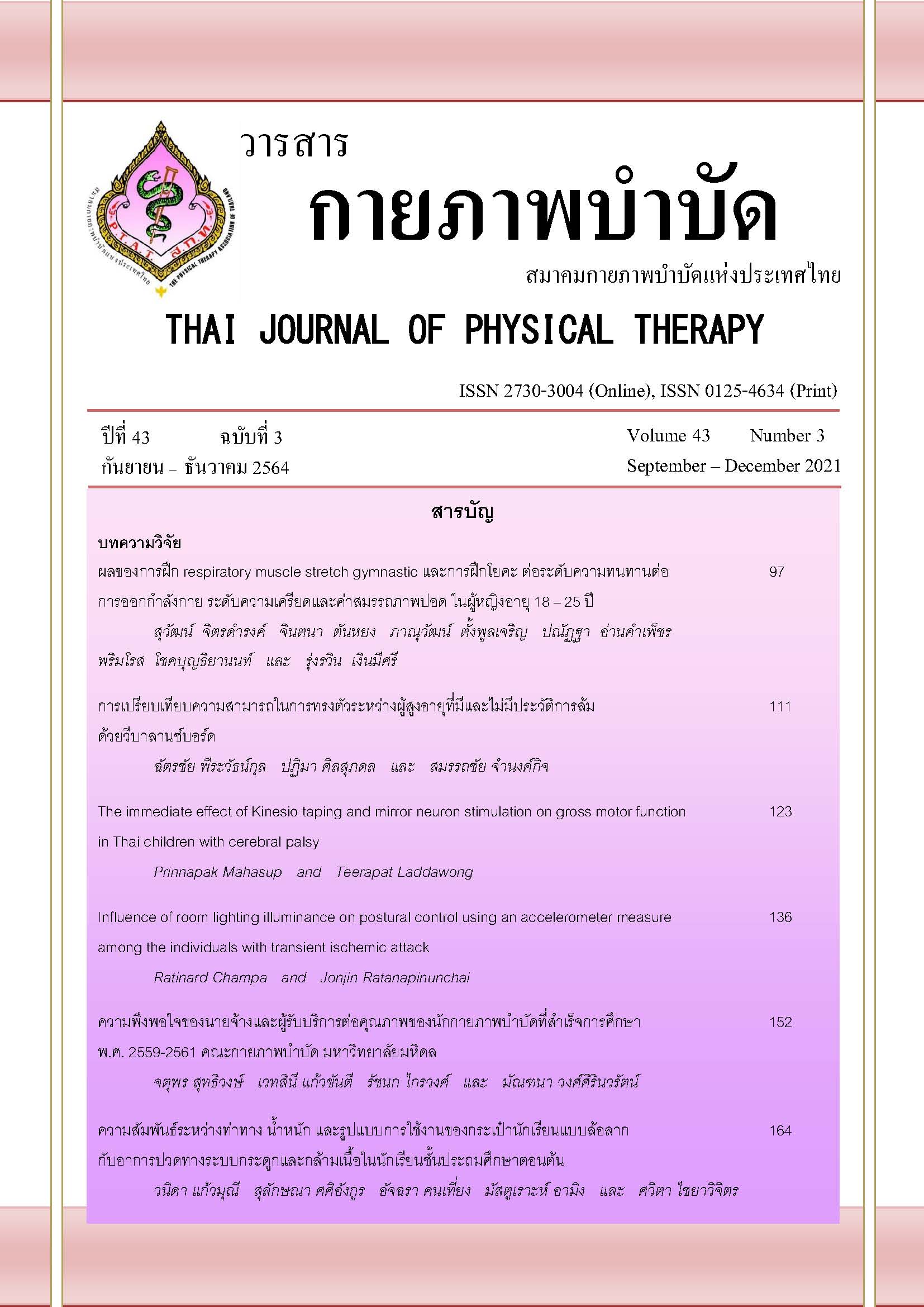อิทธิพลของระดับแสงสว่างในห้องต่อความสามารถในการทรงท่าวัดโดย accelerometer ในอาสาสมัครที่มีภาวะสมองขาดเลือดชั่วคราว การทรงท่าในผู้ป่วยที่มีภาวะสมองขาดเลือดชั่วคราว
Main Article Content
บทคัดย่อ
ที่มาและความสำคัญ: ยังไม่มีข้อสรุปที่แน่ชัดเกี่ยวกับความผิดปกติในการทรงท่าในผู้ที่มีภาวะสมองขาดเลือดชั่วคราว (TIA) ภาวะแสงไฟสลัวเป็นภาวะที่อาจพบได้บ่อยในการทำกิจกรรมในชีวิตประจำวัน อย่างไรก็ตาม ยังไม่มีหลักฐานการศึกษาเกี่ยวกับอิทธิพลของแสงไฟสลัวต่อความสามารถในการทรงท่าในผู้ที่มีภาวะ TIA
วัตถุประสงค์: เพื่อศึกษาอิทธิพลของแสงสว่างในห้องต่อความสามารถในการทรงท่าเมื่อวัดด้วย accelerometer ในภาวะแสงปกติ แสงสลัว และขณะปิดตา ในผู้ที่มีภาวะ TIA
วิธีการวิจัย: ผู้เข้าร่วมงานวิจัยที่มี TIA และผู้ที่มีสุขภาพดี (Con) ที่มีเพศและอายุตรงกันกลุ่มละ 12 คน ใช้อุปกรณ์ accelerometer วัดการแกว่งของร่างกายหรือความเร่งของเชิงกรานในแนวหน้า-หลัง (AccAP) และในแนวซ้าย-ขวา (AccML) ความเรียบลื่นในการแกว่งของเชิงกราน (JERK) และช่วงเวลาในการยืนขาเดียว (ST) ทำการทดสอบการยืนขาเดียว (SOL) การเคลื่อนไหวชดเชยในการก้าวขาไปทิศต่างๆ (Com) การทดสอบยืนบนพื้นแข็ง (Sfirm) และยืนบนพื้นนิ่ม (Sfoam) ทำการวิเคราะห์ผลโดยใช้สถิติ Two-way mixed ANOVA และการเปรียบเทียบระหว่างสองกลุ่ม
ผลการวิจัย: ภาวะแสงไฟสลัวและการปิดตาส่งผลต่อความเร่งของเชิงกราน ค่า JERK และค่า ST ของกลุ่ม TIA ในการทดสอบ SOL การเคลื่อนไหวชดเชยในการก้าวขาไปด้านข้าง (ComL) และ Sfirm โดยพบว่าเฉพาะใน TIA แสงสลัวทำให้ ST ลดลง และทำให้ค่า AccAP, AccML เพิ่มขึ้นในการทดสอบ SOL และ Sfirm และเพิ่มค่า JERK ในการทดสอบ ComL เมื่อเทียบกับแสงปกติ ถึงแม้ว่าระดับแสงจะไม่มีผลต่อ TIA ขณะทดสอบ Sfoam แต่พบว่า AccML ใน Sfoam ของ TIA มีค่ามากกว่าเมื่อเทียบกับกลุ่ม Con
สรุปผล: ผู้ที่มีภาวะ TIA มีความบกพร่องในการทรงตัวแบบไม่สามารถสังเกตเห็นได้เมื่อประเมินทางคลินิก แต่สามารถวัดการแกว่งของลำตัวได้เพิ่มขึ้นเมื่อประเมินด้วย accelerometer โดยเฉพาะในภาวะแสงไฟสลัวและปิดตา ดังนั้น การประเมินการทรงท่าร่วมกับการใช้ accelerometer และการปรับระดับแสงช่วยเพิ่มความไวของการประเมินในผู้ที่มีภาวะ TIA
Article Details
เอกสารอ้างอิง
Batchelor FA, Williams SB, Wijeratne T, Said CM, Petty S. Balance and gait impairment in transient ischemic attack and minor stroke. J Stroke Cerebrovasc Dis. 2015;24(10):2291-7.
McCollum G, Shupert CL, Nashner LM. Organizing sensory information for postural control in altered sensory environments. J Theor Biol. 1996;180(3):257-70.
Gloriani AH, Schütz AC. Humans trust central vision more than peripheral vision even in the dark. Curr Biol. 2019;29(7):1206-10.e4.
Larson AM, Loschky LC. The contributions of central versus peripheral vision to scene gist recognition. J Vis. 2009;9(10):6.1-16.
Berencsi A, Ishihara M, Imanaka K. The functional role of central and peripheral vision in the control of posture. Hum Mov Sci. 2005;24(5-6):689-709.
Gautier G, Thouvarecq R, Didier C. Visual and postural control of an arbitrary posture: the handstand. J Sports Sci. 2007;25:1271-8.
Santangelo V, Spence C. Assessing the effect of verbal working memory load on visuo-spatial exogenous orienting. Neurosci Lett. 2007;413(2):105-9.
Sally SL, Poirier FJ, Gurnsey R. Orientation discrimination across the visual field: size estimates near contrast threshold. Percept Psychophys. 2005;67(4):638-47.
Ivers RQ, Cumming RG, Mitchell P, Attebo K. Visual impairment and falls in older adults: the Blue Mountains Eye Study. J Am Geriatr Soc. 1998;46(1):58-64.
Elliott DB, Whitaker D. Clinical contrast sensitivity chart evaluation. Ophthalmic Physiol Opt. 1992;12(3):275-80.
Lord SR, Menz HB. Visual contributions to postural stability in older adults. Gerontology. 2000;46(6):306-10.
Deshpande N, Patla AE. Dynamic visual-vestibular integration during goal directed human locomotion. Exp Brain Res. 2005;166(2):237-47.
Petrofsky JS, Cuneo M, Lee S, Johnson E, Lohman E. Correlation between gait and balance in people with and without type 2 diabetes in normal and subdued light. Med Sci Monit. 2006;12(7):273-81.
Horak FB, Wrisley DM, Frank J. The Balance Evaluation Systems Test (BESTest) to differentiate balance deficits. Phys Ther. 2009;89(5):484-98.
Brown H, Siegmund G, Guskiewicz K, van den Doel K, Cretu E. Development and Validation of an Objective Balance Error Scoring System (oBESS). Med Sci Sports Exerc. 2014;46.
Mancini M, Horak FB, Zampieri C, Carlson-Kuhta P, Nutt JG, Chiari L. Trunk accelerometry reveals postural instability in untreated Parkinson's disease. Parkinsonism Relat Disord. 2011;17(7):557-62.
Easton JD, Saver JL, Albers GW, Alberts MJ, Chaturvedi S, Feldmann E, et al. Definition and evaluation of transient ischemic attack: a scientific statement for healthcare professionals from the American Heart Association/American Stroke Association Stroke Council; Council on Cardiovascular Surgery and Anesthesia; Council on Cardiovascular Radiology and Intervention; Council on Cardiovascular Nursing; and the Interdisciplinary Council on Peripheral Vascular Disease. The American Academy of Neurology affirms the value of this statement as an educational tool for neurologists. Stroke. 2009;40(6):2276-93.
Lee KB, Lim SH, Kim KH, Kim KJ, Kim YR, Chang WN, et al. Six-month functional recovery of stroke patients: a multi-time-point study. Int J Rehabil Res. 2015;38(2):173-80.
Anderson AJ, Shuey NH, Wall M. Rapid confrontation screening for peripheral visual field defects and extinction. Clin Exp Optom. 2009;92(1):45-8.
Gronfier C, Wright KP, Jr., Kronauer RE, Jewett ME, Czeisler CA. Efficacy of a single sequence of intermittent bright light pulses for delaying circadian phase in humans. Am J Physiol Endocrinol Metab. 2004;287(1):174-81.
Mancini M, Salarian A, Carlson-Kuhta P, Zampieri C, King L, Chiari L, et al. ISway: a sensitive, valid and reliable measure of postural control. J Neuroeng Rehabil. 2012;9:59.
Lugade V, Fortune E, Morrow M, Kaufman K. Validity of using tri-axial accelerometers to measure human movement - Part I: posture and movement detection. Med Eng Phys. 2014;36(2):169-76.
Brooke-Wavell K, Perrett LK, Howarth PA, Haslam RA. Influence of the visual environment on the postural stability in healthy older women. Gerontology. 2002;48(5):293-7.
Friedrich M, Grein HJ, Wicher C, Schuetze J, Mueller A, Lauenroth A, et al. Influence of pathologic and simulated visual dysfunctions on the postural system. Exp Brain Res. 2008;186(2):305-14.
D'Silva LJ, Kluding PM, Whitney SL, Dai H, Santos M. Postural sway in individuals with type 2 diabetes and concurrent benign paroxysmal positional vertigo. Int J Neurosci. 2017;127(12):1065-73.
Maki BE, McIlroy WE. The control of foot placement during compensatory stepping reactions: does speed of response take precedence over stability? IEEE Trans Rehabil Eng. 1999;7(1):80-90.
Kim KJ, Gimmon Y, Millar J, Schubert MC. Using Inertial Sensors to Quantify Postural
Sway and Gait Performance during the Tandem Walking Test. Sensors 2019;19(4):751.
Yu E, Abe M, Masani K, Kawashima N, Eto F, Haga N, et al. Evaluation of postural control in quiet standing using center of mass acceleration: comparison among the young, the elderly, and people with stroke. Arch Phys Med Rehabil. 2008;89(6):1133-9.
Mini-BESTest: Balance Evaluation Systems Test [Internet] [cited 2020 26 August]. Available from: http://www.bestest.us/files/7413/6380/7277/MiniBEST_revised_final_3_8_13.pdf.
Davson H. Light and dark adaptation [Internet] [cited 2020 16 August]. Available from: http://www.chm.bris.ac.uk/webprojects2003/white/light_and_dark_adaptation.htm.


